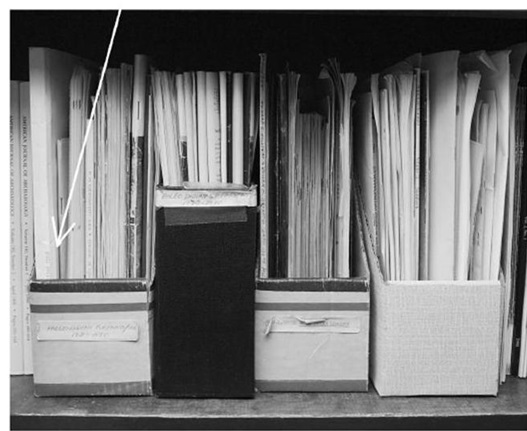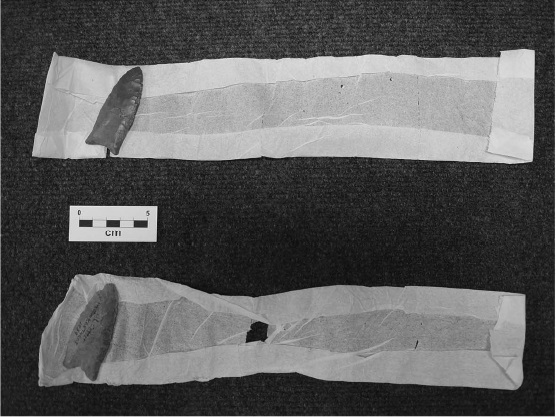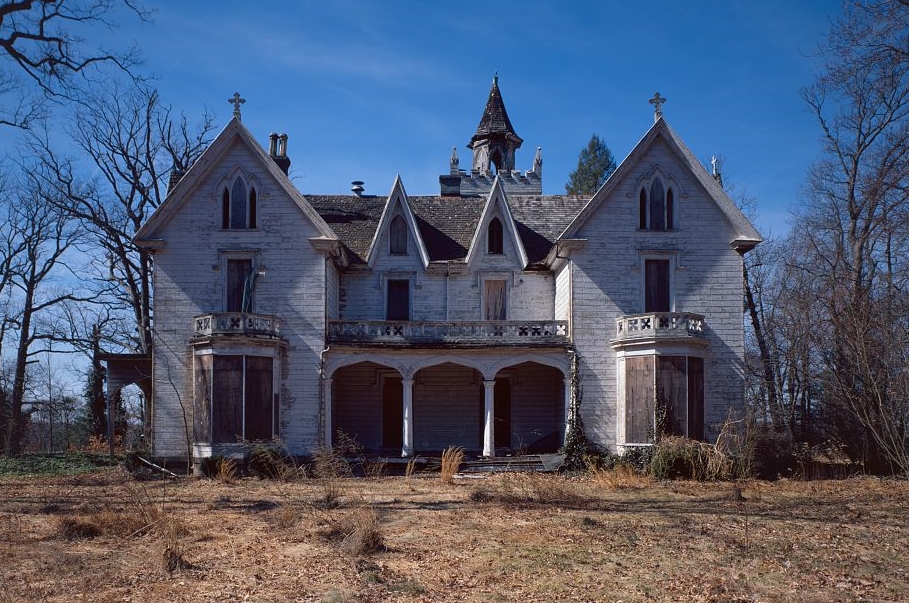Newspapers from 1836 to 1922 will be digitized and made available through the Library of Congress thanks to a grant from the NEH:
Tag: New Jersey
The Fluted Points in the File Folder
Before eminent archaeologist John Cotter passed away in 1999, he donated much of his personal library to his colleague Anthony Boldurian and the University of Pittsburgh at Greensburg. As they sorted through the books, file folders, and papers, they found something completely unexpected: a plastic sandwich bag with two neatly wrapped Clovis fluted points inside.

Cotter is best known as one of the pioneers of American historical archaeology, but he began his career studying Paleoindian archaeology, earning his M.A. in 1935. He had originally planned to write his dissertation on the Clovis material from Blackwater Draw, but by the time he returned to graduate studies at Penn in the 1950s, he had switched his subject to the excavations he had done at historic Jamestown, Virginia with the National Park Service. Yet he always maintained an interest in Paleoindian archaeology, and in fact his final publication, with Boldurian, was titled Clovis Revisited.
One of the points was labeled with his name and the location “Western Kentucky 1939.” At that time, Cotter was the state supervisor of the Archaeological Survey of Kentucky, and much of his time was spent examining the multiple excavations underway and ferrying supplies and artifacts to and from the laboratory, but there is no other contextual information for this point.
The second point is unlabeled, but made from a type of chert (Vera Cruz jasper) found in eastern Pennsylvania. The authors don’t say how difficult it was to figure this one out, but they matched this point to a photo of a fluted point found in New Jersey and published in one of the early articles on Paleoindian stone tools, Edgar B. Howard’s 1934 “Grooved Spearpoints.” That New Jersey point was in the collections of the University Museum at the University of Pennsylvania, where Cotter became a professor and curator. The authors found a drawing of the same Clovis point in the appendix of Cotter’s 1935 thesis.

The projectile point is part of the Newbold collection, accumulated by a New Jersey gentleman farmer in the second half of the nineteenth century. Michael Newbold would pay his workers as much as five cents for artifacts they found on his farm in Burlington County. After his death, the then-new University Museum acquired his collection – decades before anyone knew how old those fluted points were.
How did they end up among the paperwork? It seems likely Cotter was working with the specimens (he was particularly interested in a specific diagnostic characteristic, called basal polish or basal edge grinding, that both points have) in his office and at some point –perhaps even after his death– the bag holding them got bundled up with related articles and filed away in a bookshelf. It’s a nice example of lost artifacts being found again.

Reference:
Boldurian, Anthony T., Justin D. McKeel, and Mason G. Pickel
2012 Gifts from an archaeologist’s bookcase: John L. Cotter’s library. North American Archaeologist 33(2):193-237.
Vanity, thy name is Charlotte
The MSU Campus Archaeology site has a new post by Katy Meyers Emery about a Frozen Charlotte doll found in one of their digs.
The name comes from a poem, and later a song, about a young woman who, not wanting to cover up her pretty dress, refused to dress warmly for a long sleigh ride with her beau. When they arrived at the party, he discovered, to his horror, that Charlotte had frozen to death.
The small, inexpensive dolls do not have moving limbs – i.e., they look frozen. They were quite common in the mid to late 1800s, and may also have been easily lost or broken, as they turn up not infrequently on historical archaeological sites.
The photos below show some of the Charlottes (as well as other toys and trinkets) excavated from house sites in a former late nineteenth century working class neighborhood in Jersey City, New Jersey.

 Images from:
Images from:
Howson, Jean, and Leonard G. Bianchi
2014 Covert-Larch: Archaeology of a Jersey City Neighborhood. Data Recovery for the Route 1&9T (25) St. Paul’s Viaduct Replacement Project Jersey City, Hudson County, NJ. Cultural Resource Unit, The RBA Group, Inc.
The original post is at MSU Campus Archaeology
Creative Curation

This artifact display/birdbath was made by a private collector in New Jersey. It incorporates prehistoric stone axes and pestles, with a stone mortar on top. The unique work of art was documented by the WPA-funded Indian Site Survey in 1937. Learn more at newjerseyarchaeology.wordpress.com.
Owns It: Darlene Love, River Deep, Mountain High, Asbury Park, NJ
Nova Cæsarea: Early Maps and Mapping in New Jersey

Princeton University Library has a detailed online exhibit on the early maps of New Jersey. Lots of historic maps you can zoom in on and examples of historic surveying equipment.
Architect Louis Kahn’s “Clever House” For Sale in New Jersey
We don’t usually deal in real estate, but a striking house designed by architect Louis Kahn has just come up for sale. Kahn designed nine houses that were built around Philadelphia; this one is in Cherry Hill, New Jersey.
The Clever House is named for the clients/owners, who sought out Kahn after seeing his Trenton Bath House (according to Curbed).

Yes, it needs work (but a couple hours of raking would make the outside look so much better), but it’s under $300,000 and the property taxes aren’t too horrible (for New Jersey). And gotta love the cinder block style on the inside.

Photos are from the Real Estate Listing.
More on this house and all of Kahn’s other residential projects here.
Northeast Historical Archaeology Open Access Articles
CNEHA, the Council for Northeast Historical Archaeology, has recently made most articles in their journal, Northeast Historical Archaeology, freely available. The most recent articles (2010 and newer) are still restricted to members, but that leaves almost forty years of articles available for download.
From the first issue, you can read Dick Pin Hsu’s “The Joys of Urban Archaeology” on the excavation of the Revolutionary War period Fort Stanwix in New York. There’s also Rebecca Yamin’s early article on Raritan Landing in New Jersey and a personal favorite, a guide to agricultural drainage systems by Sherene Baugher, from which the following figure is taken.